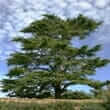Background
- Cedar is native to the mountains of the western Himalayan and the Mediterranean regions. Because moths and other insects are repelled by the scent of the wood and oil, cedar wood has been used in closets and chests to preserve fabrics and textiles. In one clinical study, patients with alopecia areata who were massaged with a combination of cedarwood oil, other aromatic oils, and carrier oils had significantly improved symptoms. However, there are currently no further well-designed studies in humans available to support the use of cedar for any condition.
- In atopic patients, cedar pollen may cause allergic symptoms, including asthma. Occupational exposure to cedar wood dust may have irritant, allergenic, or carcinogenic effects.
References
Natural Standard developed the above evidence-based information based on a thorough systematic review of the available scientific articles. For comprehensive information about alternative and complementary therapies on the professional level, go to . Selected references are listed below.
- Bist A, Kumar L, Roy I, et al. Clinico-immunologic evaluation of allergy to Himalayan tree pollen in atopic subjects in India--a new record. Asian Pac.J Allergy Immunol 2005;23(2-3):69-78.
View Abstract - Hay IC, Jamieson M, Ormerod AD. Randomized trial of aromatherapy. Successful treatment for alopecia areata. Arch Dermatol 1998;134(11):1349-1352.
View Abstract - Maciejewska A, Wojtczak J, Bielichowska-Cybula G, et al. [Biological effect of wood dust]. Med Pr 1993;44(3):277-288.
View Abstract - Ohrui T, Funayama T, Sekizawa K, et al. Effects of inhaled beclomethasone dipropionate on serum IgE levels and clinical symptoms in atopic asthma. Clin Exp Allergy 1999;29(3):357-361.
View Abstract - Singh AB, Kumar P. Aeroallergens in clinical practice of allergy in India. An overview. Ann.Agric.Environ.Med 2003;10(2):131-136.
View Abstract







